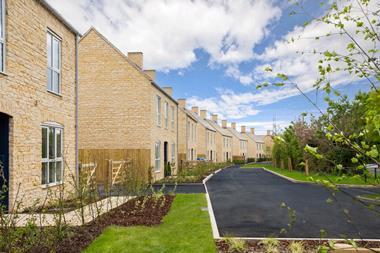David Cameron’s favourite Desert Island Discs track is (unfeasibly) Bob Dylan’s Tangled Up In Blue. It’s all about a once-fond relationship breaking down.

Could the prime minister be about to go it alone after a long love-in with the biggest housebuilders has been reported to have turned sour?
It is little surprise that David Cameron’s very first public utterance in 2016 was the announcement of yet another housebuilding initiative. Housing has been at the top of the government’s agenda since it took office last year. But the 4 January announcement hinted at an even greater sense of urgency to bump up housing production and, for once, Britain’s biggest housebuilders appear to have been ‘un-friended’, in Facebook parlance.
After years of promoting the industry’s giants, it looks as though the government has attended a DIY course, and is about to roll up its sleeves with the help of some new best friends, closer to Bob the Builder than Barratt, Bellway or Bovis.
For the first time since Lord Heseltine took an unashamedly interventionist stance in the Docklands in the early 1980s, the government will effectively become a land developer. Cameron announced the government will directly commission the building of homes on publicly owned land, in a four-site pilot scheme to deliver up to 13,000 homes, 40% of them affordable homes under the previously announced ‘starter homes’ initiative, which will provide new homes at a 20% discount to first-time buyers. It will steer sites through the planning system, decontaminating them if necessary, taking on not inconsiderable development risk, with the help of a new £1.2bn fund, and then sell them on to smaller builders, few of which have sufficient balance sheets to navigate the urban planning system.
The Telegraph’s chief political correspondent reported that the initiative reflected a government “running out of patience with big developers”. The Downing Street press release laboured the point, reminding journalists that “the top eight housebuilders provide 50% of new homes” and stating these ones will be “built at a faster rate with smaller building firms”.
Large housebuilders and their shareholders have done extremely well out of Conservative policy, most spectacularly the equity loan variety of Help to Buy, which last year supported 40%-50% of the industry behemoths’ private sales volumes, as well as the easier planning and watering down of social housing commitments. But it’s not only Telegraph political pundits who are noticing they are not delivering the step change in volumes that ministers anticipated.
The year-end and half-year trading updates from Persimmon, Barratt, Taylor Wimpey and Bovis not only showed single-digit year-on-year increases in overall volumes in the periods just gone, but also sluggish growth or reverses in the number of sites up and running - a good proxy for the likely direction of homes expected to be built in the year ahead. For instance, Barratt opened 63 new outlets against 96 a year earlier. Bovis, which is more focused on a growth strategy than its larger peers, ended the year with 101 sites - one fewer than the average for the year.
They also appear to have given a more equivocal welcome to 2015’s starter homes initiative than for Help to Buy, which has been little short of a bonanza for shareholders. This is possibly another reason that smaller builders are being given a crack of the whip in Cameron’s new-year initiative.
Small and mid-sized builders may not have the economies of scale of their larger counterparts, but, on the plus side, they do not have the significant overheads of the nationals and, critically, they generally don’t have public shareholders to keep feeding. It can hardly have escaped Whitehall’s attention that the largest groups have been paying out voluminous amounts in special dividends while stressing their discipline in land buying. Fair enough, they have been left holding the baby when splurging on land at the top of previous cycles. But this doesn’t get vast numbers of homes built.
However, providing ‘oven-ready’ land exclusively to small and medium-sized enterprises may not be quite enough. My hunch is that a ‘help-to-build’ programme may also be needed, such as a government guarantee on, say, 20% of development finance - not dissimilar to the second phase of Help to Buy mortgages - and perhaps a central design, technical and procurement resource. This would counter enduring criticism that Help to Buy has merely stoked demand rather than the supply side.
The new dalliance with smaller builders probably does not mean the government’s relationship with the big developers is All Out of Love (as soft-rock duo Air Supply - surely more to Cameron’s taste - would have it).
Alastair Stewart is building and property analyst at Progressive Equity Research




























No comments yet